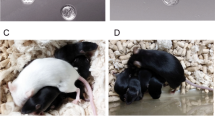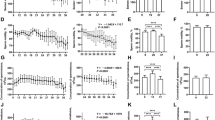Abstract
Use of non-viable somatic cells for hand-made cloning (HMC) can enable production of cloned animals from tissues obtained from elite or endangered dead animals. Buffalo skin fibroblast cells were rendered non-viable by heat treatment and used for HMC. Although fusion (93.6 ± 1.72 vs 67.1 ± 2.83%) and cleavage (90.3 ± 1.79 vs 65.8 ± 1.56%) rate was lower (P < 0.001) than that for controls, blastocysts could be successfully produced. However, blastocyst rate (34.1 ± 2.43 vs 6.9 ± 2.18%, P < 0.001) and total cell number of blastocysts (TCN, 221.3 ± 25.14 vs 151.1 ± 21.69, P < 0.05) were lower and apoptotic index (4.8 ± 1.06 vs 10.9 ± 1.21) was higher (P < 0.001) than that of controls. In another experiment, ear tissue of slaughterhouse buffaloes was preserved in mustard oil at room temperature for 48 h following which somatic cells were harvested by enzymatic digestion and used for HMC. Although fusion (96.8 ± 1.48 vs 84.2 ± 3.19%), cleavage (89.6 ± 3.59 vs 77.2 ± 3.99%), and blastocyst rate (36.9 ± 7.45 vs 13.1 ± 6.87%) were lower (P < 0.01), TCN (223.0 ± 27.89 vs 213.3 ± 28.21) and apoptotic index (3.97 ± 0.67 vs 5.22 ± 0.51) of blastocysts were similar to those of controls. In conclusion, HMC can be successfully used for production of blastocysts from non-viable cells and from cells obtained from freshly slaughtered buffaloes. This can pave the way for the restoration of farm or wild animals by HMC if somatic cells could be obtained within a few hours after their death.


Similar content being viewed by others
References
Choi YH, Love CC, Chung YG, Varner DD, Westhusin ME, Burghardt RC, Hinrichs K (2002) Production of nuclear transfer horse embryos by piezo-driven injection of somatic cell nuclei and activation with stallion sperm cytosolic extract. Biol Reprod 67:561–567
Crane-Robinson C, Read MC, Cary PD, Driscoll PC, Dragan AI, Privalov PL (1998)The energetics of HMG box interactions with DNA. J Mol Biol 281:705–717.
Dong YJ, Bai XJ, Varisanga MD, Mtango NR, Otoi T, Rajamahendran R, Suzuki T (2004) Production of cloned calves by the transfer of somatic cells derived from frozen tissues using simple portable CO2 incubator. Asian-Aust J AnimSci 17:168–173
Folch J, Cocero MJ, Chesne P, Alabart JL, Dominguez V, Cognie Y, Roche A, Fernandez-Arias A, Marti JI, Sanchez P, Echegoyen E, Beckers JF, Bonastre AS, Vignon X (2009) First birth of an animal from an extinct subspecies (Capra pyrenaicapyrenaica) by cloning. Theriogenology 71(6):1026–1034
Hong SB, Uhm SJ, Lee HY, Park CY, Gupta MK, Chung BH, Chung KS, Lee HT (2005) Developmental ability of bovine embryos nuclear transferred with frozen-thawed or cooled donor cells. Asian-Aust J AnimSci 18(9):1242–1248.
Hoshino Y, Hayashi N, Taniguchi S, Kobayashi N, Sakai K, Otani T, Iritani A, Saeki K (2009) Resurrection of a bull by cloning from organs frozen without cryoprotectant in a −80 degrees C freezer for a decade. PLoS One 4(1):e4142
Iuso D, Czernik M, Di Egidio F, Sampino S, Zacchini F, Bochenek M, Smorag Z, Modlinski JA, Ptak G, Loi P (2013) Genomic stability of lyophilized sheep somatic cells before and after nuclear transfer. PLoS One 8(1):e51317
Loi P, Clinton M, Barboni B, Fulka J Jr, Cappai P, Feil R, Moor RM, Ptak G (2002) Nuclei of nonviable ovine somatic cells develop into lambs after nuclear transplantation. Biol Reprod 67(1):126–132
Loi P, Matsukawa K, Ptak G, Clinton M, Fulka J Jr, Nathan Y, Arav A (2008) Freeze-dried somatic cells direct embryonic development after nuclear transfer. PLoS One 3(8):e2978
Onishi A, Iwamoto M, Akita T, Mikawa S, Takeda K, Awata T, Hanada H, Perry AC (2000) Pig cloning by microinjection of fetal fibroblast nuclei. Science 289(5482):1188–1190
Roti Roti JL, Kampiga HH, Malyapa RS, Wright WD, van der Waal RP, Xu M (1998) Nuclear matrix as a target for hyperthermic killing of cancer cells. Cell Stress Chaperones 3:245–255
Selokar NL, Saini M, Palta P, Chauhan MS, Manik RS, Singla SK (2014) Hope for restoration of dead valuable bulls through cloning using donor somatic cells isolated from cryopreserved semen. PLoS One 9(3):e90755.
Selokar NL, St John L, Revay T, King WA, Singla SK, Madan P (2013) Effect of histone deacetylase inhibitor valproic acid treatment on donor cell growth characteristics, cell cycle arrest, apoptosis and handmade cloned bovine embryo production efficiency. Cell Rep 15:531–542
Shi D, Lu F, Wei Y, Cui K, Yang S, Wei J, Liu Q (2007) Buffalos (Bubalus bubalis) cloned by nuclear transfer of somatic cells. Biol Reprod 77:285–291
Trounson A, Lacham-Kaplan O, Diamente M, Gougoulidis T (1998) Reprogramming cattle somatic cells by isolated nuclear injection. Reprod Fertil Dev 10:645–650
Turgis M, Han J, Caillet S, Lacroix M (2009) Antimicrobial activity of mustard essential oil against Escherichia coli O157:H7 and Salmonella typhi. Food Control 20:1073–1079
Vajta G (2007) Handmade cloning: the future way of nuclear transfer? Trends Biotechnol 25(6):250–253
Vajta G, Lewis IM, Hyttel P, Thouas GA, Trounson AO (2001) Somatic cell cloning without micromanipulators. Cloning 3:89–95
Vajta G, Maddox-Hyttel P, Skou CT, Tecirlioglu RT, Peura TT, Lai L, Murphy CN, Prather RS, Kragh PM, Callesen H (2005) Highly efficient and reliable chemically assisted enucleation method for handmade cloning in cattle. Reprod Fertil Dev 17:791–797
Wakayama S, Ohta H, Hikichi T, Mizutani E, Iwaki T, Kanagawa O, Wakayama T (2008) Production of healthy cloned mice from bodies frozen at −20 degrees C for 16 years. Proc Natl Acad Sci U S A 105(45):17318–17322
Wilmut I, Schniek AE, McWhir J, Kind AJ, Campbell KHS (1997) Viable offspring derived from fetal and adult mammalian cells. Nature 385:810–813
Wolf D, Rauch J, Hausmann M, Cremer C (1999) Comparison of the thermal denaturation behavior of DNA-solutions and metaphase chromosome preparation in suspension. Biophys Chem 81:207–221
Acknowledgments
The present work was funded by the National Agriculture Innovative Project (NAIP) grant to SKS (C 2-1-(5)/2007) and MSC (C-2067 and 075). SKM and AS are recipients of CSIR-SRF fellowship and TJS is a recipient of ICMR fellowship.
Author information
Authors and Affiliations
Corresponding author
Additional information
Editor: Tetsuji Okamoto
Rights and permissions
About this article
Cite this article
Duah, E.K.A., Mohapatra, S.K., Sood, T.J. et al. Production of hand-made cloned buffalo (Bubalus bubalis) embryos from non-viable somatic cells. In Vitro Cell.Dev.Biol.-Animal 52, 983–988 (2016). https://doi.org/10.1007/s11626-016-0071-8
Received:
Accepted:
Published:
Issue Date:
DOI: https://doi.org/10.1007/s11626-016-0071-8




